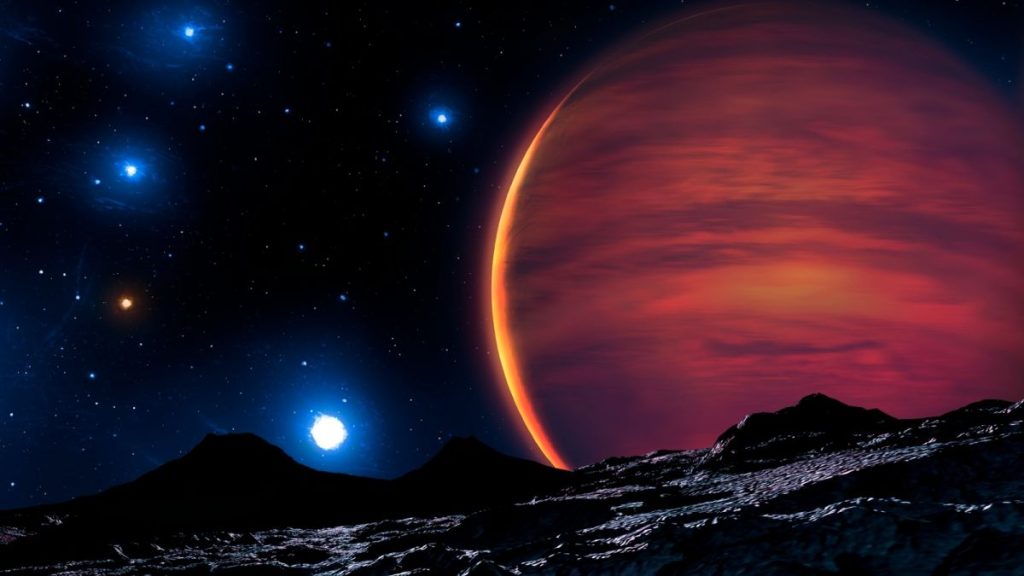An artist’s interpretation of what a brown dwarf star may look like from an exoplanet that orbits one. (Image credit: GETTY/MARK GARLICK/SCIENCE PHOTO LIBRARY)
Researchers have detected surprising radio signals coming from a tiny, “ultracool” star that should not be able to give off the radiation bursts. The peculiar celestial object, which blurs the line between a planet and a star, could help scientists learn more about how small stars evolve.
The object, named T8 Dwarf WISE J062309.94−045624.6 (W0623), is a so-called brown dwarf. This kind of “protostar” has a composition similar to gas giants like Jupiter, but it can fuse hydrogen atoms, without being able to sustain full-scale nuclear fusion at its core like most stars do. W0623, which was first discovered in 2011, is around 37 light-years from Earth. It has a radius somewhere between 0.65 and 0.95 times that of Jupiter and a mass around 44 times greater than the gas giant, making it highly dense.
W0623’s dim surface is around 800 degrees Fahrenheit (425 degrees Celsius), which is colder than a typical campfire. For comparison, the sun‘s surface burns at 6,700 F to 14,000 F (3,700 C to 7,700 C).
In a new study published July 13 in The Astrophysical Journal Letters, researchers revealed that W0623 emits faint radio waves, making it the coldest star ever detected to give off this type of electromagnetic radiation, which is normally produced by much larger and hotter stars.
“It’s very rare to find ultracool brown dwarf stars like this producing radio emissions,” study lead author Kovi Rose, a doctoral candidate at the University of Sydney, said in a statement. “That’s because their dynamics do not usually produce the magnetic fields that generate radio emissions detectable from Earth.” It is a really “neat discovery,” he added.
Related: This collapsed star is turning into a gigantic diamond before our eyes
Brown dwarf stars are a cross between a gas giant planet and a small star. (Image credit: Getty/Stocktrek Images)
Experts think only around 10% of brown dwarfs emit radio waves, and most of those brown dwarfs have surfaces that are around 4,000 F (2,200 C), the researchers wrote in the statement. As a result, it is “not fully known” why W0623 — which is much colder — is giving off signals that can be detected from Earth, they added.
Larger main-sequence stars like the sun generate radio signals thanks to their intense magnetic fields, which are generated by their superhot cores. By comparison, the magnetic fields of brown dwarfs are fairly weak due to their lack of nuclear fusion.
Instead, the researchers think the radio-emitting brown dwarfs’ magnetic fields rotate much more quickly than their ionized upper atmospheres do. This would create an electrical flow, with electrons falling toward the magnetic polar regions of the stars. When combined with the star’s rotation, the electrical rain creates regularly repeating radio bursts, the researchers wrote.
The coldest star ever discovered is another brown dwarf, known as W0855, which would not be out of place in the Arctic, with a temperature somewhere between minus 54 F and 8 F (minus 48 C and minus 13 C), according to NASA. But not all brown dwarfs are so cold.
In June, astronomers detected a brown dwarf, known as WD0032-317B, that is a blistering 13,900 F (7,700 C). At this temperature, any molecule in the star’s upper atmosphere would immediately break down into its component atoms. However, WD0032-317B reaches this extreme temperature only because it is locked in a supertight orbit with a blazing white dwarf star, which it orbits every 2.3 hours.
Astronomers are particularly interested in brown dwarfs because of how closely they toe the line between star and planet.
“These stars are a kind of missing link between the smallest stars that burn hydrogen in nuclear reactions and the largest gas giant planets, like Jupiter,” Rose said. Learning more about them could help reveal how both types of celestial bodies evolve, he added.

